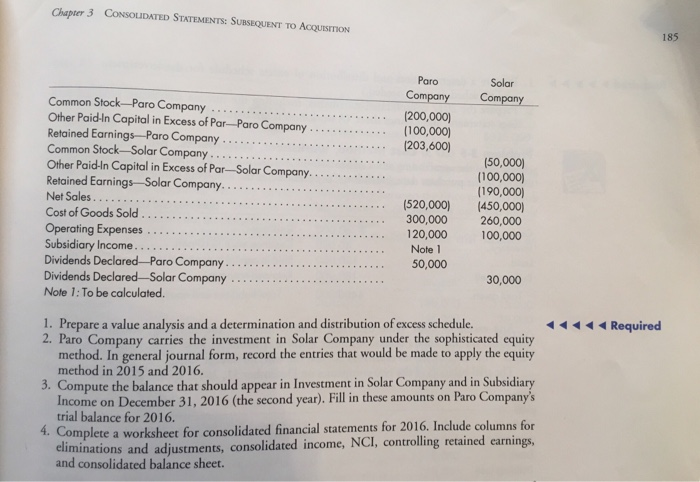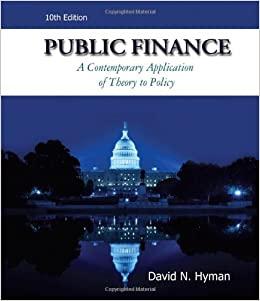and consolidated balance sheet. Problem 3-3 (LO 4) Sophisticated equity method adjustments, consolidated worksheet. (This is the same as Problem 3-2, except that the sophisticated equity method is used.) On January 1, 2015, Paro Company purchases 80% of the common stock of Solar Com- pany for $320,000. On this date, Solar has comimon stock, other paid-in capital in excess of par, and retained earnings of $50,000, $100,000, and $150,000, respectively. Net income and dividends for two years for Solar Company are as follows: 2016 2015 $90,000 30,000 $60,000 Net income 20,000 Dividends. On January 1, 2015, the only undervalued tangible assets of Solar are inventory and the building. Inventory, for which FIFO is used, is worth $10,000 more than cost. The inventory is sold in 2015. The building, which is worth $30,000 more than book value, has a remaining life of 10 years, and straight-line depreciation is used. The remaining is attributable to goodwill. The trial balances for Paro and Solar are as excess of cost over book value follows: Solar Paro Company Company Inventory, December 31 Other Current Assets Investment in Solar Company 50,000 100,000 136,000 180,000 Note Land.. 50,000 320,000 (60,000) Buildings and Equipment.. Accumulated Depreciation Goodwill.... 50,000 350,000 (100,000) Other Intangibles. Current Liabilities 20,000 Bonds Payable.. Other Long-Term Liabilities (40,000) (100,000) (120,000) (200,000) Chapter 3 CONSOLIDATED STATEMENTS: SUBSEQUENT TO ACQUISITION 185 Paro Solar Company Company Common Stock- Paro Company Other Paid-In Capital in Excess of Par-Paro Company Retained Earnings-Paro Company Common Stock-Solar Company Other Paid-In Capital in Excess of Par-Solar Company. Retained Earnings-Solar Company. Net Sales... Cost of Goods Sold (200,000) (100,000) (203,600) (50,000) (100,000) (190,000) (450,000) 260,000 100,000 (520,000) 300,000 120,000 Operating Expenses Subsidiary Income. . Dividends Declared-Paro Company Dividends Declared-Solar Company Note 1: To be calculated Note 1 50,000 30,000 1. Prepare a value analysis and a determination and distribution of excess schedule. 2. Paro Company carries the investment in Solar Company under the sophisticated equity method. In general journal form, record the entries that would be made to apply the equity method in 2015 and 2016. 3. Compute the balance that should appear in Investment in Solar Company and in Subsidiary Income on December 31, 2016 (the second year). Fill in these amounts on Paro Company's trial balance for 2016. 4. Complete a worksheet for consolidated financial statements for 2016. Include columns for eliminations and adjustments, consolidated income, NCI, controlling retained earnings, and consolidated balance sheet. AARequired and consolidated balance sheet. Problem 3-3 (LO 4) Sophisticated equity method adjustments, consolidated worksheet. (This is the same as Problem 3-2, except that the sophisticated equity method is used.) On January 1, 2015, Paro Company purchases 80% of the common stock of Solar Com- pany for $320,000. On this date, Solar has comimon stock, other paid-in capital in excess of par, and retained earnings of $50,000, $100,000, and $150,000, respectively. Net income and dividends for two years for Solar Company are as follows: 2016 2015 $90,000 30,000 $60,000 Net income 20,000 Dividends. On January 1, 2015, the only undervalued tangible assets of Solar are inventory and the building. Inventory, for which FIFO is used, is worth $10,000 more than cost. The inventory is sold in 2015. The building, which is worth $30,000 more than book value, has a remaining life of 10 years, and straight-line depreciation is used. The remaining is attributable to goodwill. The trial balances for Paro and Solar are as excess of cost over book value follows: Solar Paro Company Company Inventory, December 31 Other Current Assets Investment in Solar Company 50,000 100,000 136,000 180,000 Note Land.. 50,000 320,000 (60,000) Buildings and Equipment.. Accumulated Depreciation Goodwill.... 50,000 350,000 (100,000) Other Intangibles. Current Liabilities 20,000 Bonds Payable.. Other Long-Term Liabilities (40,000) (100,000) (120,000) (200,000) Chapter 3 CONSOLIDATED STATEMENTS: SUBSEQUENT TO ACQUISITION 185 Paro Solar Company Company Common Stock- Paro Company Other Paid-In Capital in Excess of Par-Paro Company Retained Earnings-Paro Company Common Stock-Solar Company Other Paid-In Capital in Excess of Par-Solar Company. Retained Earnings-Solar Company. Net Sales... Cost of Goods Sold (200,000) (100,000) (203,600) (50,000) (100,000) (190,000) (450,000) 260,000 100,000 (520,000) 300,000 120,000 Operating Expenses Subsidiary Income. . Dividends Declared-Paro Company Dividends Declared-Solar Company Note 1: To be calculated Note 1 50,000 30,000 1. Prepare a value analysis and a determination and distribution of excess schedule. 2. Paro Company carries the investment in Solar Company under the sophisticated equity method. In general journal form, record the entries that would be made to apply the equity method in 2015 and 2016. 3. Compute the balance that should appear in Investment in Solar Company and in Subsidiary Income on December 31, 2016 (the second year). Fill in these amounts on Paro Company's trial balance for 2016. 4. Complete a worksheet for consolidated financial statements for 2016. Include columns for eliminations and adjustments, consolidated income, NCI, controlling retained earnings, and consolidated balance sheet. AARequired








